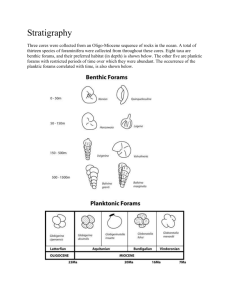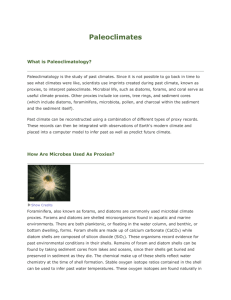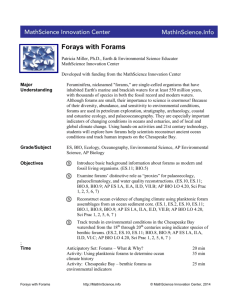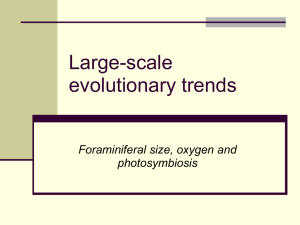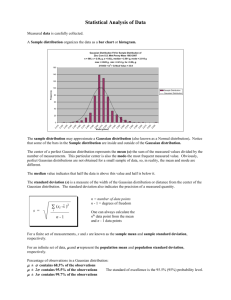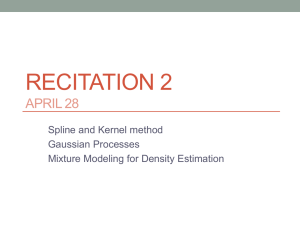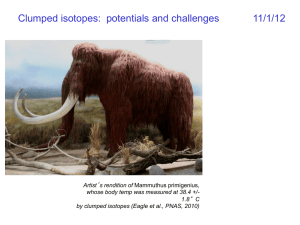Size-Frequency distribution of Orbitolina Texana Foraminifera
advertisement
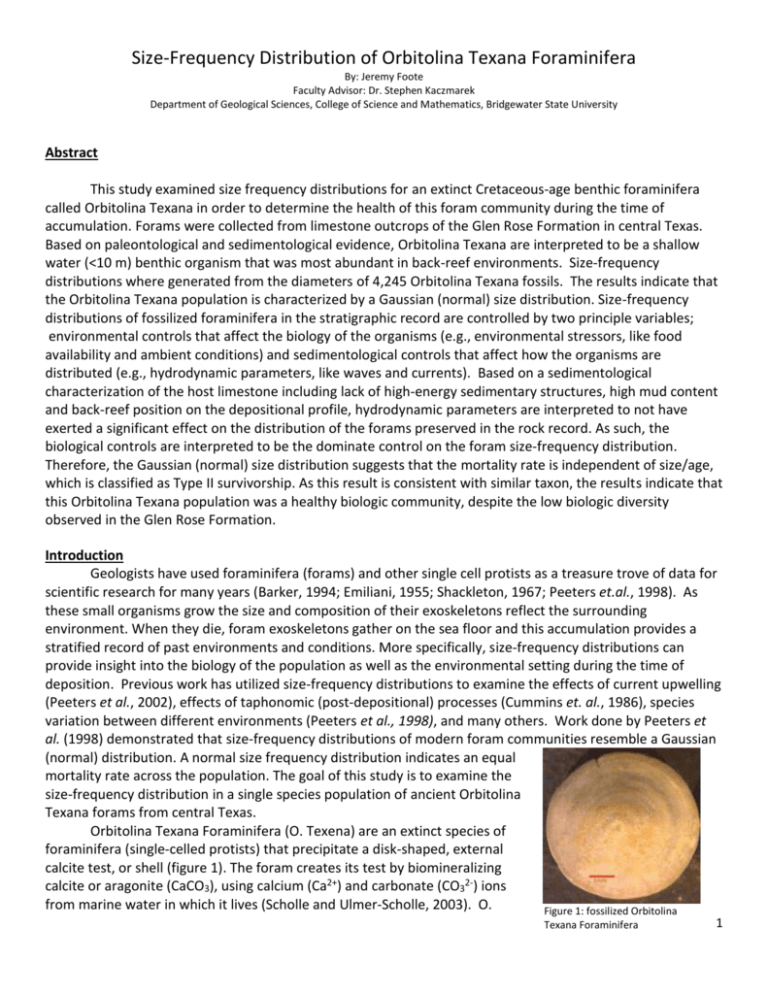
Size-Frequency Distribution of Orbitolina Texana Foraminifera By: Jeremy Foote Faculty Advisor: Dr. Stephen Kaczmarek Department of Geological Sciences, College of Science and Mathematics, Bridgewater State University Abstract This study examined size frequency distributions for an extinct Cretaceous-age benthic foraminifera called Orbitolina Texana in order to determine the health of this foram community during the time of accumulation. Forams were collected from limestone outcrops of the Glen Rose Formation in central Texas. Based on paleontological and sedimentological evidence, Orbitolina Texana are interpreted to be a shallow water (<10 m) benthic organism that was most abundant in back-reef environments. Size-frequency distributions where generated from the diameters of 4,245 Orbitolina Texana fossils. The results indicate that the Orbitolina Texana population is characterized by a Gaussian (normal) size distribution. Size-frequency distributions of fossilized foraminifera in the stratigraphic record are controlled by two principle variables; environmental controls that affect the biology of the organisms (e.g., environmental stressors, like food availability and ambient conditions) and sedimentological controls that affect how the organisms are distributed (e.g., hydrodynamic parameters, like waves and currents). Based on a sedimentological characterization of the host limestone including lack of high-energy sedimentary structures, high mud content and back-reef position on the depositional profile, hydrodynamic parameters are interpreted to not have exerted a significant effect on the distribution of the forams preserved in the rock record. As such, the biological controls are interpreted to be the dominate control on the foram size-frequency distribution. Therefore, the Gaussian (normal) size distribution suggests that the mortality rate is independent of size/age, which is classified as Type II survivorship. As this result is consistent with similar taxon, the results indicate that this Orbitolina Texana population was a healthy biologic community, despite the low biologic diversity observed in the Glen Rose Formation. Introduction Geologists have used foraminifera (forams) and other single cell protists as a treasure trove of data for scientific research for many years (Barker, 1994; Emiliani, 1955; Shackleton, 1967; Peeters et.al., 1998). As these small organisms grow the size and composition of their exoskeletons reflect the surrounding environment. When they die, foram exoskeletons gather on the sea floor and this accumulation provides a stratified record of past environments and conditions. More specifically, size-frequency distributions can provide insight into the biology of the population as well as the environmental setting during the time of deposition. Previous work has utilized size-frequency distributions to examine the effects of current upwelling (Peeters et al., 2002), effects of taphonomic (post-depositional) processes (Cummins et. al., 1986), species variation between different environments (Peeters et al., 1998), and many others. Work done by Peeters et al. (1998) demonstrated that size-frequency distributions of modern foram communities resemble a Gaussian (normal) distribution. A normal size frequency distribution indicates an equal mortality rate across the population. The goal of this study is to examine the size-frequency distribution in a single species population of ancient Orbitolina Texana forams from central Texas. Orbitolina Texana Foraminifera (O. Texena) are an extinct species of foraminifera (single-celled protists) that precipitate a disk-shaped, external calcite test, or shell (figure 1). The foram creates its test by biomineralizing calcite or aragonite (CaCO3), using calcium (Ca2+) and carbonate (CO32-) ions from marine water in which it lives (Scholle and Ulmer-Scholle, 2003). O. Figure 1: fossilized Orbitolina Texana Foraminifera 1 Texana test are multi-chambered, a characteristic of their modular growth. As the forams grow, they precipitate a slightly larger chamber to accommodate increasing size during its life cycle. Forams commonly measure less than 0.1 mm to 1 mm in diameter, but they can grow to nearly 20 cm in diameter (Scholle and Ulmer-Scholle, 2003). Orbitolina Texana forams are exclusively found in the lower member of the Glen Rose limestone (Barker, 1944; Douglass, 1960; Behres, 1964) (Figure 2). O. Texana was extant during the early portion of the Cretaceous period in the Albian (100 MYA) and Aptian (126 MYA) Eras (Douglass, 1960). The lower member of the Glen Rose limestone extends from central Texas to southern Florida (figure 3). Further discussion of the Glen Rose limestone can be found in Barker et al. (1994), Foote et al. (1988) and Stricklin and Smith (1973). The presence of benthic forams in the lower member of the Glen Rose formation allows a number of assumptions to be made about the depositional environment. Sustained benthic foram production requires water with a salinity level of 16‰ to 36‰, a temperature of 20-25° C, and proximity to currents that replenish food and nutrients. Optimal environments are also physically distant Figure 2: A stratigraphic from a large influx of fresh water and siliciclastic material, like sand and mud column of the Glen Rose subgroup. (Foote, 88) (Schlager, 2005). Orbitolina Texana resided on the sea floor in the substratum region of a shallow marine environment (Figure 4). The natural distributions of benthic forams are controlled by two inversely co-varying parameters, which are the availability of food (diatoms) and oxygen (Koho, 2008), as well as other environmental conditions required for carbonate precipitation, such as water clarity, light, water temperature, depth and water salinity. If there is not a sufficient supply of diatoms, there will be a high mortality rate of juvenile forams (Koho, 2008). O. Texana forams are sessile, meaning that they lack the ability to move on their own. Therefore only two principle variables affect their distribution in sediments and rock, biological and environmental conditions. It is generally understood that the size-frequency distribution of any population is dependent on the growth rate, mortality rate and processes that affect the species as they transit from the biosphere to the lithosphere by way of fossilization (i.e. taphonomic processes) (Cummins et al., 1986). For example, some taphonomic processes that could physically affect forams are Figure 3: Map showing location of high energy hydrodynamics processes such as wind-driven waves, strong dam spillway in Central currents and storms, which could enhance fracturing, abrasion and bioerosion. Canyon Texas. Diagenetic processes, like dissolution, cementation and micritization could also change the morphology of foram tests after deposition. As a result, taphonomic processes could exert a strong control on the size-frequency distribution of a population of ancient forams. Figure 4: The interpreted depositional environment for foram production is the platform interior of a carbonate platform, which is located behind a barrier. An indication that the platform interior is a low energy area is the presence of a packstone sedimentary rock, which is only present in low energy areas as well as the lack of high-energy sedimentary structures. 2 This study focuses on investigating the controls on the size-frequency distribution of a community of O. Texana, and attempts to evaluate the trend in the size-frequency distribution of that community in the context of biological and taphonomic processes. A size-frequency distribution curve of O. Texana can provide insight into how the forams lived and how they were preserved in the rock record. However, one of the major challenges with interpreting size frequency distributions of a fossilized species in the rock record is that there are processes that can adversely affect the quality of that record. This means that the manner in which the distribution deviates from a normal distribution, as documented in modern forams, may indicate biological stresses in the environment, or post-life (taphonomic) processes. Methods Two student teams measured the diameters of 4,245 individual foams using Chicago Brand 6" Duel Steele Calipers. Orbitolina Texana have relatively small fossilized tests (< 8 mm in diameter) so tweezers were used to hold the forams and ensure accurate measurement. Foram tests where assumed to be perfectly circular and were measured across the diameter of the non-fractured axis. Samples were collected by S. Kaczmarek in 2009 and were stored in glass vials. O. Texana were separated from other skeletal material within the samples. A number of the forams had adhered to each other, creating a cluster of forams. Foram clusters were not measured. Fractured forams were used only when > 50 % of the foram test was present an could be properly measured across the diameter of the nonfractured surface. However, the frequency of fractured forams was very low. Individual forams were measured to the nearest 0.1 mm. Measurements were recorded directly into a Microsoft Excel spreadsheet to perform data analysis. The data were analyzed using three statistical techniques. The first binning approach used two different bin sizes in order to create a size frequency histogram. The first histogram had bin sizes of 0.1 mm. The 0.1 mm bin histogram was created by counting the number of forams between certain sizes, in 0.1 mm increments. Plotting the frequency of a given bin size against the range of sizes created a size-frequency distribution of the recorded diameters of the forams. The second histogram used only 2 bins, which allowed grouping size data into values greater than or less than the measured median value. The number of forams that were equal to the calculated median size where not included in this histogram, only those measurements that where greater than or less than the median value. This allowed for an examination of the distribution of sizes on either side of the median to give a clear picture of how the measurements may be skewed. The third statistical approach compared two bell curves that were mathematically modeled using the data points and generated statistics. The second bell curve is an idealized Gaussian size frequency distribution created by modeling an idealized set of synthetic data points equal to the same number of measured data points (N=4,245). This approach allowed me to compare a size-frequency curve generated from the measured diameters to an idealized Gaussian size-frequency curve for the same number of data points. How close the measured forams match an idealized size-frequency distribution could be examined by comparing the two curves. Results The minimum measured diameter was 0.9 mm and the maximum measured diameter was 8.00 mm, and the mean, median and mode were 3.72 mm, 3.70 mm and 3.00 mm, respectively. Figure 5 shows that the size frequency histogram (0.1 mm bins) is characterized by a near-normal (Gaussian) distribution. The distribution is not perfectly normal because the mean, median and mode are slightly different, thus indicating a slight right skewness. A right skewness occurs when there are more measured data points to the right of the statistical mean value of the collected data. 3 The two bin histogram, which grouped the measured values into greater than or less than the median bins indicates that the size-frequency distribution is right skewed (not shown). However, there is only a difference of 8 forams between the forams larger and the forams smaller than the median, which corresponds to a difference of only a 0.19%. Figure 6 compares the size-frequency curves for the measured data to the idealized Gaussian distribution model. The curve based on the measured dataset has an almost identical shape to the mathematically modelled synthetic dataset. The measured data is set slightly to the left of the idealized Gaussian distribution model and the tails of the measured data are shorter than the idealized Gaussian distribution model. 180 Frequency (Number of forams) 160 140 120 100 80 60 40 20 0 Foram Diameter (mm) Figure 5: Size-frequancy distribution histogram (0.1 mm bin) showing a near normal (Gaussian) distribution. Frequency (Number of forams) 1600 Measured data 1400 Idealized Gaussian distribution model 1200 Measured data median 1000 800 600 400 200 0 0 1 2 3 4 Foram Diameter (mm) 5 6 7 8 9 Figure 6: A bell curve for the measured and modeled data shows that the size-frequency distribution closely resembles a true Gaussian distribution. 4 Discussion Biological, environmental and taphonomic factors may play varying roles in the size- frequency distribution of any fossilized species. The biology of an organism will determine where it can go, how it eats, whether it is mobile or sessile, its life span and its mortality rate. The environmental factors are forces and variables outside a creature's control, such as waves, current, water quality, amount of sunshine or available food supply. Taphonomic processes may alter the preserved remains of an organism after it dies. The data obtained from the measurements of the 4,245 forams produced a near Gaussian size-frequency distribution, but in order to interpret this distribution, environmental and other taphonomic factors must be accounted for. The O. Texana are extremely simple creatures. They are born, ingest food, grow and die. O. Texana are sessile benthic forams, meaning that never gain their own form of mobility. This means that the only way for the forams to be transported from the area where they live is by hydrodynamic forces. The portion of the Glen Rose limestone where the O. Texana is found is interpreted as a low energy platform interior (Behres, 1964). This interpretation is supported by the lack of fractured foram tests, the abundance of other marine fossils (high biological diversity) in adjacent stratigraphic layers, lack of high energy sedimentary structures, a relatively high carbonate mud content in the layer where the forams were collected and interstratified wackestone and mudstone layers (carbonate mud supported limestone) (S. Kaczmarek, personal communication). A low energy environment also lessens the impact of taphonomic processes acting on O. Texana fossils. Low energy conditions aids in preservation of fossil material because other material does not break or fracture the forams during collisions while being transported along the sea floor, the high mud content also provides a cushion during compaction. The various forms of protection from high energy conditions surrounding the O. Texan organism and fossils allow a more complete record to be lithified and preserved in the stratigraphy. Because the environmental and taphonomic factors that affect the O. Texana are interpreted to be minor, the primary controls on the size-frequency distribution of the O. Texana are likely to be biological. If this is the case, then the mortality rate is the main biological control on size-frequency distribution of the studied O. Texana. Previous work completed by Peeters et al., 1998, examined the size-frequency distribution of nine species of modern forams in the Arabian Sea. The nine foram species all had a Gaussian (normal) sizefrequency distribution, indicating that a healthy community of forams (ancient or modern) would share this trait of having a Gaussian (normal) size distribution. The Gaussian (normal) size distribution of the varied foram species means that they also share a type II survivorship curve, which suggests that the probability of death is independent of size/age for the forams. The population of Cretaceous O. Texana produce a normal (Gaussian) size distribution, thus indicating that this ancient species follows the same survivorship curve (type II) as other previously examined modern foram species. Taking into account that the size-frequency distribution of the O. Texana is likely to be primarily controlled by its mortality rate, a Gaussian distribution of their size leads to the interpretation that the mortality rate of the O. Texana is uniform regardless of age. With the size-frequency distribution for the O. Texana following the same trends as other members of this taxon, this community of Orbitolina Texana Foraminifera is interpreted to be a healthy foram community, which is consistent with additional sedimentological and stratigraphic observations. 5 Conclusions The size-frequency distribution of a single species is controlled by both biological, environmental and taphonomic factors. When environmental and taphonomic parameters are insignificant, a size distribution better reflects the biological controls on the organism. The measured diameters of 4,245 ancient Orbitolina Texana forams studied here produced a near-normal (Gaussian) size-frequency distribution. Both geologist and biologist define this as a normal size-frequency distribution curve when applied to a continually growing indeterminate growth species because it suggests that the mortality rate is uniform across all age groups within the population (Type II survivorship). Because it was determined, based on sedimentological evidence, that hydrodynamic and taphonomic parameters do not exert a significant effect on the distribution of the forams before being preserved in the rock record, biological parameters can be viewed as the dominant control on the size-frequency distribution of O. Texana foraminifera from the Glen Rose Fm. As the nearnormal size distribution result presented here for ancient forams is consistent with similar modern taxon, it is concluded that this Orbitolina Texana population was a healthy biologic community. References Barker, R., Bush, P. and Baker Jr., E.T., (1994) Geologic History and Hydrogeologic Setting of the EdwardsTrinity Aquifer System, West-Central Texas U.S. GEOLOGICAL SURVEY Water-Resources Investigations. Report 94-4039 Behres, William E., (1964) Environmental reconstruction for part of the Glen Rose limestone. Sedimentology, issue 4 (60-111). Elsevier Publishing company, Amsterdam Cummins, H., Powell, R. J., Stanton, JR., and Staff, G., (1986) The size-frequency distribution in palaeoecology: Effects of taphonomic processes during formation of Mollusca death assemblages in Texas bays. Paleontology, Vol 29, Part 3, , pp. 495-518 Douglass, R.C., (1960) The Foraminifera Genus Orbitolina in North America. Geological survey Professional Paper 333. United States Government Printing Office, Washington. Emiliani, C. (1955). Pleistocene temperatures. Journal of Geology, 63, 538–578. Foote, R., Massingill, L. and Wells, R., (1998) Petroleum geology and the distribution of conventional crude oil, natural gas, and natural gas liquids, East Texas basin Open-File Report 88-450K Koho, K., (2008) Benthic foraminifera: ecological indicators of past and present oceanic environments - A glance at the modern assemblages from the Portuguese submarine canyons. Geologi, Issue 60. The Netherlands. Peeters, F., Ivanova, E., Conan, S., Brummer, GJ., Ganssen, G., Troelstra, S. and Hinte, J., (1998) A size analysis of planktic foraminifera from the Arabian Sea. Marine Micropaleontology. Issue 39, pp 31-363 Peeters, F., Brummer, G. and Ganssen, G., (2002) The effect of upwelling on the distribution and stable isotope composition of Globigerina bulloides and Globigerinoides ruber (planktic foraminifera) in modern surface waters of the NW Arabian Sea. Global and Planetary Change 34. 269–291 Scholle, Peter A., Ulmer-Scholle and Dana S. (2003) AAPG Memoir: 77 A Color Guide to the Petrography of Carbonate Rocks: Grains, textures, porosity, diagenesis. Oklahoma: AAPG,. PDF Shackleton, N. J. (1967). Oxygen isotope analyses and Pleistocene temperatures reassessed. Nature, 215, 15– 17. Stricklin, F. and Smith, C., (1973) Environmental Reconstruction of a Carbonate Beach Complex: Cow Creek (Lower Cretaceous) Formation of Central Texas Geological Society of America Bulletin, v. 84, p. 13491368 6 7
